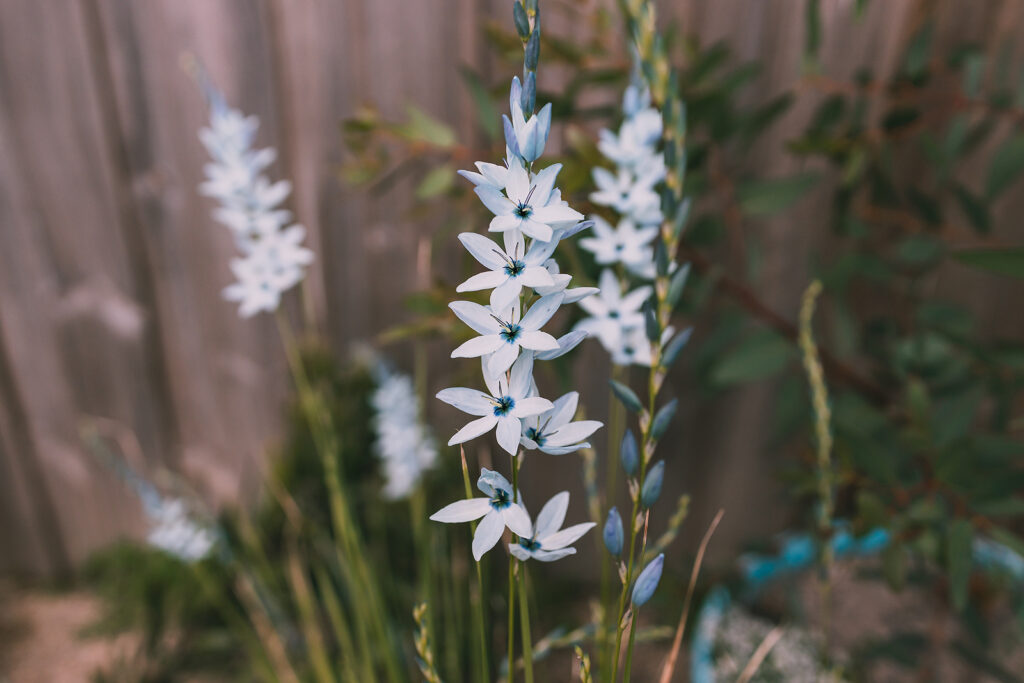Ixia species is commonly grown for its showy clusters of star-shaped flowers borne on thin, wiry stems. Ixia flowers from spring to summer and comes in a range of bright colors– orange, pink, red, white, and yellow with contrasting centers.
Ixia species is commonly called ixias, corn lilies, and wand flowers. Individual blooms have six petal-like tepals. Flowers appear on long, loose spikes above grass-like mostly basal leaves. A few small leaves appear on the long flowering spikes. Flowers are arranged in two ranks or rows.
Ixia is grown from corms. Corms will rot if left in wet soil, especially in winter. Plant Ixia on mounds in regions where there is plentiful rainfall.
From 40 to 50 species belong to this genus. Ixia is native to South Africa.

Get to know Ixia – Corn Lily
- Plant type: Corm, perennial
- Growing zones and range: Zones 7 to 9
- Hardiness: Hardy
- Height and width: 6 to 36 inches (15-91cm) tall and half as wide
- Form: Grass-like, swordlike basal leaves to 20 inches (50cm) long
- Flowers: Clusters of open, 6-petaled, often aromatic flowers to 1½ inch (38mm) wide; colors are orange, pink, red, white, and yellow with contrasting centers.
- Bloom time: Late-spring to summer
- Uses: Grow Ixia in beds and containers; plant Ixia in drifts; a good choice for cottage gardens and small gardens; good cut flower.
- Common name: Corn lily
- Botanical name: Ixia spp.
- Family name: Iridaceae
Where to plant Ixia – Corn Lily
- Plant Ixia in full sun.
- Plant Ixia in sandy to humus-rich, well-drained loam.
- Ixia prefers dry soil during its dormant winter period.
- Ixia prefers a soil pH of 6.5-7.0.
- Where Ixia is marginally hardy, plant them in a protected spot such as a south-facing wall.

When to plant Ixia – Corn Lily
- Plant Ixia in autumn in Zones 9-10.
- Plant Ixia in spring in Zones 4-8.
Planting and spacing Ixia – Corn Lily
- Set corms 2 to 3 inches (50-75mm) deep in the garden.
- In pots, plant Ixia 1 inch (2.5cm) deep.
- Space Ixia 3 to 4 inches (7.5-10cm) apart.
How to water and feed Ixia – Corn Lily
- Keep the soil evenly moist but not wet; they should never be wet or completely dry.
- Fertilize Ixia with an all-purpose fertilizer during the growing season.
- Ixia growing in containers should be fed a dilute, balanced fertilizer every two weeks through the growing season.

Ixia – Corn Lily care
- Mulch around Ixia in Zones 7 and warmer to conserve soil moisture.
- Mulch over Ixia left in the garden through the winter; place pine needles or evergreen boughs over Ixia to protect it from freezing temperatures.
- Where Ixia is not hardy, treat the corm like gladiolus, dig them up after the foliage has died back and store them in a cool, dry place in a paper bag until they can be replanted in spring.
- In wet winter regions, lift corms after the foliage dies back and store them in dry soil at 50° to 60°F (10°-16°C).
- Ixia growing in containers can be left in the containers through winter if the soil is allowed to dry out and the containers are kept at about 50° to 60°F (10°-16°C).
Ixia – Corn Lily pests and diseases
- Ixia resists pests and diseases.
Ixia – Corn Lily propagation
- Ixia is propagated by cormels and seed.
- Separate offsets (cormels) in late summer after the leaves die down.
Ixia – Corn Lily varieties to grow
- Ixia hybrids. There are many Ixia hybrids. Most grow 12 to 16 inches (30-40cm) tall; hybrids include ‘Blue Bird’ which bears white flower with dark purple centers, ‘Marble’ has magenta-pink flowers, ‘Marquette’ has yellow flowers with purple-red centers, ‘Panorama’ bears hot pink flowers with purple centers, ‘Rose Emperor’ has rose-pink flowers with magenta centers.
- I. maculata grows 6 to 20 inches (15-50cm tall) and bears yellow or orange blooms with dark purple centers.
- I. viridiflora grows to 24 inches (61cm) tall and bears spikes of pale green flowers with black centers rimmed in violet-purple.















